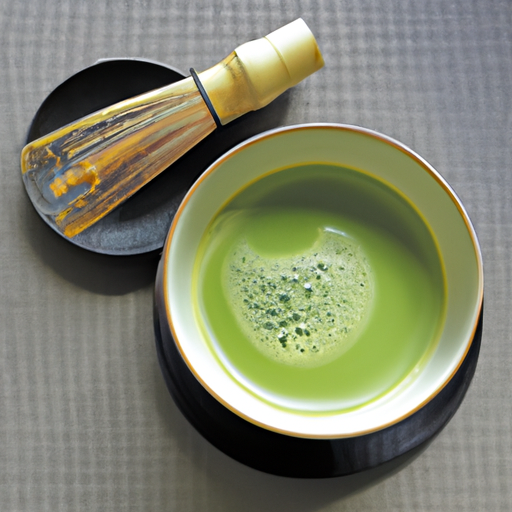I’ve recently uncovered the marvels of matcha powder and am thrilled to divulge my discoveries to you. For those not acquainted, matcha powder consists of finely milled green tea leaves, cultivated and prepared through a specific process. It’s a fundamental element in traditional Japanese tea rituals and has surged in popularity lately due to its health advantages and its diverse uses in culinary practices.
In this article, I’ll be exploring the various ways you can use matcha powder, from traditional tea ceremonies to creative culinary applications. I’ll also be discussing the health benefits of matcha powder, how to choose the right type, and tips and tricks for storing and handling it.
Whether you’re a longtime matcha lover or a curious newcomer, there’s something for everyone in this guide to what to do with matcha powder.
Key Takeaways
- Matcha powder can be used in various ways in the kitchen, such as adding it to smoothies, lattes, baking, and desserts. It can also be used in salad dressings and sauces.
- Matcha provides numerous health benefits, such as boosting metabolism, improving focus and concentration, and providing a calming effect. It is also packed with antioxidants and essential vitamins and minerals.
- Matcha tea ceremonies involve precise movements and gestures to create harmony and connection with the natural world. Proper etiquette is important when participating in a tea ceremony.
- Matcha powder can also be used for skincare, such as in face masks, exfoliating scrubs, and toners. It’s important to choose high-quality, organic matcha powder sourced from Japan for skincare.
What is Matcha Powder?
You might be wondering what matcha powder is, but don’t worry, it’s just finely ground green tea leaves that pack a powerful punch of antioxidants. Matcha comes from the Camellia sinensis plant, which is native to China and grown in Japan. The history of matcha powder dates back to the Tang dynasty in China, where it was used in tea ceremonies.
Matcha gained popularity in Japan during the 12th century and has been a staple in Japanese culture ever since. There are different grades and quality levels of matcha powder, which can affect the taste and nutritional value. The highest grade is ceremonial grade, which is made from the youngest leaves and has a vibrant green color and sweet taste.
The next grade is premium grade, which is made from slightly older leaves and has a slightly bitter taste. The lowest grade is culinary grade, which is made from older leaves and is best used in cooking or baking. Matcha powder is known for its numerous health benefits, including boosting metabolism, improving focus and concentration, and providing a calming effect.
These benefits are due to the high concentration of antioxidants, caffeine, and amino acids in matcha powder. So, if you’re looking for a healthy alternative to your morning coffee, matcha powder might just be what you need.
Health Benefits of Matcha Powder
If you’re looking for a natural source of antioxidants, incorporating matcha into your daily routine can provide numerous health benefits. Matcha powder is one of the most nutritious superfoods available, packed with vitamins and minerals that are essential for our body’s overall health.
In fact, matcha contains 137 times more antioxidants than regular green tea, making it a powerful tool in fighting free radicals that cause cell damage.
In addition to its antioxidant properties, matcha powder can also aid in weight loss. One study found that consuming matcha powder can increase metabolism and help burn calories. The green tea compounds in matcha, like catechins and caffeine, can also help reduce abdominal fat and lower cholesterol levels.
Incorporating matcha into your daily routine can be a helpful addition to a healthy diet and exercise routine.
Overall, matcha powder is a nutritious and beneficial addition to any diet. Its high antioxidant content and potential for aiding in weight loss make it a valuable tool in maintaining overall health.
In the next section, we will explore the traditional use of matcha powder and its cultural significance.
Traditional Use of Matcha Powder
I’ll introduce the traditional use of matcha powder, including preparing matcha tea and tea ceremonies.
To prepare matcha tea, one needs to whisk the powder with hot water until it becomes frothy.
Tea ceremonies, on the other hand, are elaborate and formal events that have been part of Japanese culture for centuries.
Adjusting the paragraph structure in the input makes it easier to read and understand. Using contractions also makes the text more conversational.
Preparing Matcha Tea
To prepare matcha tea, simply sift 1-2 teaspoons of matcha powder into a bowl, add hot water, and whisk until frothy. It’s important to use a whisking technique that incorporates both vertical and circular movements to create a smooth, creamy texture.
Additionally, using ceremonial grade matcha powder ensures a high quality and authentic taste. Matcha tea is often used in traditional Japanese tea ceremonies, which emphasize mindfulness and focus. These ceremonies involve a series of precise movements and gestures, meant to create a sense of harmony and connection with the natural world.
While preparing matcha tea at home may not involve all of the rituals of a formal tea ceremony, taking the time to properly prepare and enjoy this special beverage can be a meditative and calming experience.
Tea Ceremonies
Tea ceremonies are steeped in tradition and offer a unique opportunity to connect with Japanese culture and mindfulness practices. They are an integral part of Japanese culture and have been practiced for centuries. The ceremony typically involves the preparation and serving of matcha tea, which is made from finely ground green tea leaves. The ceremony is not just about drinking tea, but also about the mindfulness and meditation that is associated with it.
Tea ceremony etiquette is very important in Japanese culture. It is essential to follow proper etiquette when participating in a tea ceremony. This includes arriving on time, removing your shoes, and bowing to the host. It is also important to show respect by not speaking loudly, not touching the tea utensils, and not using your phone during the ceremony. The cultural significance of tea ceremonies in Japan cannot be overstated, as they represent a way of life that is deeply rooted in tradition and mindfulness practices.
Tea ceremonies are just one way to enjoy matcha, but there are many creative ways to use matcha powder in the kitchen.
Creative Ways to Use Matcha Powder in the Kitchen
I love experimenting with matcha powder in the kitchen and I’ve discovered some creative ways to use it beyond the traditional tea ceremony.
Adding matcha to smoothies and lattes is a great way to incorporate it into your daily routine. It’s also a unique and flavorful ingredient to use in baking and desserts.
Finally, I’ve found that matcha can add a delicious twist to salad dressings and sauces.
Smoothies and Lattes
Adding matcha powder to your smoothies and lattes can transform your morning routine into a healthy and energizing ritual. Not only does matcha powder provide a boost of antioxidants and caffeine, but it also adds a unique and satisfying flavor to your drinks. Here are some ideas for matcha smoothie recipes and matcha latte variations to incorporate into your daily routine.
| Matcha Smoothie Recipes | Ingredients | Directions |
|---|---|---|
| Matcha Mango Smoothie | 1 cup frozen mango chunks | Blend all ingredients together in a blender until smooth. Enjoy immediately. |
| Matcha Banana Protein Smoothie | 1 ripe banana | Combine all ingredients in a blender and blend until smooth. Serve immediately. |
| Matcha Avocado Smoothie | 1/2 ripe avocado | Combine all ingredients in a blender and blend until smooth. Serve immediately. |
| Matcha Berry Blast Smoothie | 1 cup mixed frozen berries | Blend all ingredients together in a blender until smooth. Enjoy immediately. |
Whether you prefer a fruity or creamy matcha drink, these recipes are a great way to start your day. But don’t limit yourself to just smoothies and lattes – matcha powder can also be used in baking and desserts. Let’s explore some unique ways to incorporate matcha into your sweet treats.
Baking and Desserts
You’re in for a treat when it comes to incorporating matcha powder into your baked goods and desserts. Matcha infused treats are becoming increasingly popular, and it’s no wonder why.
Matcha has a unique flavor that adds a new dimension to your sweet treats, and its vibrant green color lends itself perfectly to visually stunning desserts.
Sweet and savory matcha recipes are both worth exploring. The bitterness of matcha powder can complement the sweetness of sugar, making it a versatile ingredient in desserts like cakes, cookies, and ice cream. But matcha powder can also be used in savory recipes like matcha infused pasta, matcha glazed salmon, and matcha rice.
The possibilities are endless when it comes to incorporating this wonderful ingredient into your cooking. Now, let’s move on to the next section about salad dressings and sauces.
Salad Dressings and Sauces
Get ready to elevate your salads and sauces with the unique flavor of matcha-infused dressings and sauces. Matcha powder can add a subtle yet distinct flavor to your dressings and sauces, making them more interesting and flavorful. When mixed with other ingredients, matcha can create a harmonious blend of flavors that can complement and enhance the taste of your dishes.
To create a matcha dressing or sauce, you can mix matcha powder with a variety of ingredients such as olive oil, vinegar, lemon juice, soy sauce, honey, garlic, and ginger. The possibilities are endless, and you can experiment with different flavor combinations to find the perfect matcha dressing or sauce for your salad or dish. Here are some recipe examples that you can try:
| Recipe | Ingredients | Directions |
|---|---|---|
| Matcha vinaigrette | Olive oil, white wine vinegar, honey, matcha powder, salt, pepper | Whisk all ingredients together in a bowl until well combined. Drizzle over your favorite salad. |
| Matcha ginger sauce | Soy sauce, rice vinegar, honey, matcha powder, ginger, garlic | Mix all ingredients in a small bowl until smooth. Use as a dipping sauce for sushi or vegetables. |
| Matcha honey mustard | Dijon mustard, honey, matcha powder, lemon juice, salt, pepper | In a bowl, whisk together all ingredients until well combined. Serve as a dressing for your favorite sandwich or as a dipping sauce for chicken tenders. |
As you can see, matcha powder can be a versatile ingredient in your kitchen. Not only does it add a unique flavor, but it also provides health benefits such as antioxidants and energy-boosting properties. But did you know that matcha powder can also be used for skincare? Let’s explore that in the next section.
Matcha Powder for Skincare
If you’re looking for a natural way to rejuvenate your skin, try incorporating matcha powder into your skincare routine. Matcha facials and DIY skincare recipes are gaining popularity due to the numerous benefits of matcha powder for the skin.
This vibrant green powder is rich in antioxidants, which help to protect the skin from harmful free radicals that can cause premature aging. Matcha powder also contains chlorophyll, which has natural detoxifying properties that can help to remove impurities from the skin. Additionally, the caffeine in matcha can help to reduce inflammation and puffiness, leaving your skin looking and feeling refreshed.
Some effective DIY skincare recipes using matcha powder include face masks, exfoliating scrubs, and toners. But before you dive into using matcha powder for your skincare routine, it’s important to choose the right matcha powder.
Look for high-quality, organic matcha powder that has been sourced from Japan. Cheaper, lower quality matcha powders may contain additives or have a bitter taste, which can be harmful to your skin. With the right matcha powder, you can enjoy all the benefits of this superfood for your skin.
Choosing the Right Matcha Powder
To fully enjoy the benefits of matcha in your skincare routine, it’s crucial to select a high-quality, organic powder sourced from Japan, ensuring its purity and effectiveness. Matcha is graded based on its quality, with the highest grade being ceremonial grade and the lowest being culinary grade.
If you want to use matcha for skincare, it’s best to choose ceremonial grade matcha as it undergoes a more rigorous cultivation and processing method, resulting in a higher concentration of antioxidants and amino acids. Culinary grade matcha, on the other hand, is better suited for cooking and baking due to its stronger flavor profile.
Aside from grades, matcha also has different flavor profiles that can impact your choice. Matcha can be described as grassy, vegetal, sweet, or even bitter, depending on the cultivar, location, and processing method.
If you’re new to matcha, it’s recommended to start with a more mellow and sweet flavor profile, such as Uji matcha, which is known for its balance of umami and sweetness. However, if you prefer a stronger and more complex flavor, you can opt for matcha from Yame or Kirishima, which are known for their astringency and depth of flavor.
Choosing the right matcha powder can make a significant difference in the quality and effectiveness of your skincare routine. By selecting a high-quality, organic, and ceremonial grade matcha powder with a flavor profile that suits your taste, you can ensure that you’re getting the most out of this powerful ingredient.
In the next section, we’ll discuss how to properly store and handle matcha powder to maintain its freshness and potency.
Storing and Handling Matcha Powder
Properly storing and handling matcha powder is key to preserving its freshness and potency, ensuring that it delivers maximum benefits to your skin. When it comes to storing matcha powder, it is essential to keep it away from air, light, heat, and moisture, as exposure to these elements can cause it to lose its flavor and nutritional value. The best way to store matcha powder is to keep it in an airtight container, preferably made of opaque material, such as ceramic or tin, and place it in a cool, dry, and dark place, such as a pantry or cupboard.
In addition to storing matcha powder correctly, handling it properly is also crucial. When preparing matcha powder, it’s best to use a bamboo whisk or spoon to avoid metal or plastic utensils that can affect the taste and quality of the powder. Moreover, it’s vital to sift the powder before use to ensure that it’s free of lumps and clumps. Sifting also helps to aerate the powder, allowing it to dissolve better in liquids and producing a smoother texture.
It’s essential to use matcha powder within its expiration date to ensure its freshness and potency. As matcha powder ages, it loses its flavor and nutritional value, making it less effective in delivering its benefits to the skin. Therefore, it’s best to purchase matcha powder in small quantities and use it regularly to maximize its benefits.
Transitioning into the subsequent section about ‘tips and tricks for using matcha powder,’ there are many creative ways to incorporate matcha powder into your skincare routine.
Tips and Tricks for Using Matcha Powder
Now that we know how to properly store and handle matcha powder, let’s explore some tips and tricks for using it in various recipes.
One unexpected way to use matcha powder is as a seasoning. Its vibrant green color and earthy taste can add a unique twist to savory dishes like roasted vegetables, grilled meats, and even popcorn. Just sprinkle a small amount on top of your dish and enjoy the burst of flavor it brings.
Another fun way to incorporate matcha powder into your cooking is by using it in cocktails. Matcha powder pairs well with gin, vodka, and even tequila. You can mix it with honey or simple syrup to create a sweet and tangy base for your drinks. Or, if you’re feeling adventurous, try making a matcha-infused gin or vodka by soaking the powder in the alcohol for a few hours.
Lastly, don’t be afraid to experiment with matcha powder in your baking. It can be added to muffins, breads, and even cakes for a subtle green tea flavor. Just be sure to sift the powder before using it to avoid any clumps.
With these tips and tricks, you’ll be able to make the most out of your matcha powder and impress your guests with your culinary skills.
Frequently Asked Questions
How is Matcha Powder produced?
Matcha powder is produced using a traditional Japanese method that involves organic farming of shade-grown tea leaves. The tea plants are shaded for several weeks before harvesting, which increases the chlorophyll levels and enhances the flavor and color of the leaves.
After harvesting, the leaves are steamed, dried and sorted, and then ground into a fine powder using a stone mill. The resulting powder is known for its vibrant green color, distinct flavor, and ceremonial use in Japanese tea ceremonies.
The use of organic farming methods ensures that the matcha powder is free from harmful chemicals and pesticides, making it a healthier option for consumption.
Can Matcha Powder be used in drinks other than tea?
Matcha powder can definitely be used in drinks other than tea. In fact, it’s become quite popular to incorporate matcha into cocktails and smoothies for an added boost of antioxidants and flavor.
Matcha cocktails often feature the powder mixed with various alcohols, such as vodka or gin, along with other ingredients like lemon juice and simple syrup.
Matcha smoothies, on the other hand, often include the powder blended with fruits like bananas or berries, along with almond milk or yogurt for added creaminess.
Whether you prefer a boozy beverage or a healthy smoothie, matcha powder can add a unique and delicious twist to your drinks.
Is there a difference in taste between different grades of Matcha Powder?
When it comes to the taste of different grades of matcha powder, there are definitely noticeable differences. Higher quality matcha tends to have a sweeter, smoother taste, with more nuanced flavor notes such as floral or nutty undertones. Lower quality matcha, on the other hand, can taste more bitter and astringent, with less complexity in flavor.
These tasting notes are important to consider when using matcha in different culinary applications, as the quality of the powder can impact the overall taste of the dish. For example, higher grade matcha might be better suited for desserts or lighter dishes, while lower grade matcha could work well in heartier, savory dishes.
Ultimately, it’s up to personal preference and experimentation to find the best matcha for each individual application.
How long does Matcha Powder stay fresh after opening?
According to my research, matcha powder can stay fresh for up to six months if properly stored in an airtight container in a cool, dry place away from direct sunlight.
It’s important to note that the quality of the matcha powder can affect its shelf life, so it’s best to use higher grade matcha powder for longer storage.
Additionally, using expired matcha powder can result in a bitter taste and loss of health benefits, so it’s recommended to use fresh matcha powder for optimal flavor and benefits.
There are several ways to store matcha powder, including using airtight containers, storing in the refrigerator or freezer, and using desiccant packets to absorb moisture.
Overall, proper storage and use of fresh matcha powder can result in a delicious and healthy addition to your diet.
Can Matcha Powder be used in savory dishes?
Matcha powder can certainly be used in savory dishes to create unique flavor combinations. The earthy and slightly bitter taste of matcha powder can be a great addition to various savory dishes, such as stir-fries, soups, and marinades.
It can also be used to make savory sauces and dips, like a matcha-infused aioli or a creamy matcha dressing for salads. When adding matcha powder to savory dishes, it’s important to use it sparingly and balance it with other flavors to avoid overpowering the dish.
With its versatility and distinctive taste, matcha powder can be a great ingredient to experiment with in savory cooking.
Conclusion
As a matcha lover, I can tell you that this vibrant green powder is so much more than just a trendy ingredient. It’s a powerhouse of antioxidants and nutrients that can benefit your health and skin.
Whether you enjoy it in a traditional tea ceremony or experiment with matcha-infused recipes, there are endless ways to incorporate this versatile powder into your daily routine. Think of matcha as a superhero that can elevate your meals and self-care routine to the next level.
With the right knowledge and techniques, you can unleash its full potential and reap the rewards. So go ahead, grab a bag of high-quality matcha powder, and let your creativity run wild. Your taste buds and skin will thank you!










